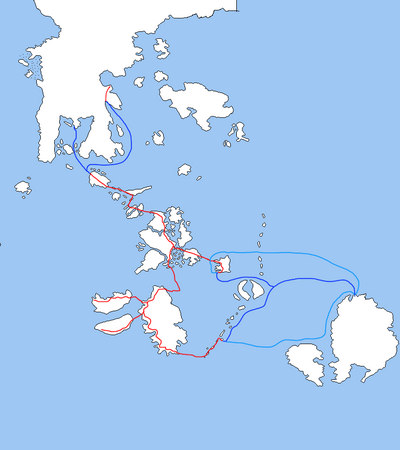Grand Royal and Federal Railway
The Grand Royal and Federal Railway or in the Zunzhal Ishashi'ka (Literally the Shashi/Scanderan highway) is a series of shipping lanes and railways that stretches from Imerbürg in the north to Nya Landborg in the far south, while the northern and southern stretches of the railway is contrary to what the name suggest shipping routes operated by royally owned naval and air ships is the rest of the route a large collection of railway bridges that crosses the great shallow Vattnafalten. While crossing over several realms is the railway itself not considered the preview of the local realms and their vassal lord, but the route itself and the land it's own is considered part of the crownland of the federation and as such owned not by the federation itself, nor by it's vassal realms but it's instead operated by the dynast of the Stjärkhrone household and as such part of the royal household rather than the federal authorities. Of course as with most things in the federation is it very hard to separate the royal household from the day to day operation of the federation and while a neat bit of trivia does it despite this operate as part of the federal apparatus.
However where that separation comes into play however is that it operates as part of the royal household's duties towards the commonry in their role as liege lords, this means that tickets for lower class trains are free even if passengers' luggage are inspected and passports or any other kind of identifications are often checked. However for the upper burghers and the aristocracy are more suitable accommodations also provided however tickets for the burgher class is sold and tickets for the aristocracy are paid for by the noble estate collectively each year as part of the annual tribute paid by the landless, low, and high aristocrazy each year. The only exception to this is the Dawn Nobility, the few houses that can trace their lineage back to the dawn age, it remains unclear why these houses are not expected to pay the Stjärnhkrone household but annual payment here has never been asked for about this specific project. This means that passager trains are often divided into three parts, aristorcatic carts are often kept in the front, upper class carts are held in the middle of the trains, and finally the lower class trains are driving in the back.
These railway networks however also transport a lot of cargo and each year does the royal merchant guild also collectively pay a large fee for the right to use the railway bridge, this fee on it's own is often where most of the upkeep of the bridge comes from and serve as a large source of revenue for the royal household and the federal budget itself as a lot of the house hold's own surplus is often invested into the federal budget.
Routes
The start of the route begins either in Imerbürg or kopperborg where rail connect the Vedian capital to Vargastad in the far north where two shipping routes take passengers to Öborga in Jarna where the rail network proper start, from here can one travel the length of Vattnafalten and almost every federal realm in the huge shallow sea is in some way connected except for Izalta proper, the end of the railway lies either in Leporidaeria or in the Izalta islands where once again the water becomes too deep for a railway network to be feasible and shipping resume by either ship or by airship but in more recent days have boat aeroplanes also taken up some slack here.
Construction
The true impressive scale of the railway bridge is certainly something very impressive, the construction began in the early 19th century and took almost 5 decades to complete and relied on not only huge impressive feats of engineering but also large scale of work crews as well as military expeditions to defend the railway and to subjugate tribes and free princes that attempted to halt such a construction as well as diplomatic missions and several marriages were arranged between princesses and princes of the royal household and several at the time independent Zunzhal princes to allow for the construction.
The use of slaves, Corvée labourers, indentured servants, and even prison labour have historically been seen as an obvious part of large scale construction in the federation however in recent years have this issue come a bit more to the forefront and High King Primus have spoken out in gratitude of the sacrifices made by such a labour force and federal as well as royal house hold authorities have in recent years officially stated that they regret that such a thing was done, the high king even mentioned it as "A dark shame upon such a glorious project".
The Grand Royal and Federal Railway in federal culture and media
In the federation is the railway often used as a setting, very popular for mystery or romance novels and it's often mentioned when characters are traveling. The high ranking railcarts especially are often looked upon as sources of great fancy and high class. Similarly is the creation of the railway a very popular setting for various adventure novels where brave labourers, adventures, or military men must fend off savage tribesmen or scheming princes attempting to stop it's construction.
